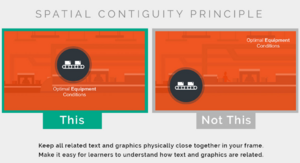Spatial Contiguity Principle: Difference between revisions
No edit summary |
No edit summary |
||
| Line 3: | Line 3: | ||
'''Students learn better when corresponding words and pictures are presented near each other than far from each other on the page or screen(Mayer et al. 1989).''' | '''Students learn better when corresponding words and pictures are presented near each other than far from each other on the page or screen(Mayer et al. 1989).''' | ||
As one of [https://ectwiki.online/index.php?title=Mayer%27s_Principles_in_Multimedia_Learning Mayer's 12 Principles of Multimedia Learning], the Spatial Contiguity Principle refers to a close together distance in the actual space between relevant text and visuals on the screen. When the corresponding words and pictures are far from each other, we define it as ''separated presentation''. Spatial contiguity is created when we use an integrated presentation in which each illustration is placed next to the text that describes it, and words have been inserted into the illustration. By this, Learners have cues for combining corresponding words and images that save their working memory during cognitive processing. | As one of [https://ectwiki.online/index.php?title=Mayer%27s_Principles_in_Multimedia_Learning Mayer's 12 Principles of Multimedia Learning], the Spatial Contiguity Principle refers to a close together distance in the actual space between relevant text and visuals on the screen. When the corresponding words and pictures are far from each other, we define it as ''separated presentation''. Spatial contiguity is created when we use an integrated presentation in which each illustration is placed next to the text that describes it, and words have been inserted into the illustration. By this, Learners have cues for combining corresponding words and images that save their working memory during cognitive processing. This principle is important to consider when developing e-learning modules because it allows for meaningful learning by creating a mental connection between words and images. | ||
=='''Evidence'''== | |||
[[File:Spatial contiguity 2.png|thumb|300px|'''Spatial contiguity''']] | |||
'''Placing printed words near the graphics they describe to guide the learner's cognitive processing helps to reduce extraneous processing.''' | |||
=='''Reference'''== | =='''Reference'''== | ||
Mayer’s 12 Principles of Multimedia Learning: Introduction. (n.d.-b). https://www.skillsandparticipation.co.uk/mod/book/view.php?id=11085 | Mayer’s 12 Principles of Multimedia Learning: Introduction. (n.d.-b). https://www.skillsandparticipation.co.uk/mod/book/view.php?id=11085 | ||
Revision as of 18:03, 16 December 2022
Overview
Students learn better when corresponding words and pictures are presented near each other than far from each other on the page or screen(Mayer et al. 1989).
As one of Mayer's 12 Principles of Multimedia Learning, the Spatial Contiguity Principle refers to a close together distance in the actual space between relevant text and visuals on the screen. When the corresponding words and pictures are far from each other, we define it as separated presentation. Spatial contiguity is created when we use an integrated presentation in which each illustration is placed next to the text that describes it, and words have been inserted into the illustration. By this, Learners have cues for combining corresponding words and images that save their working memory during cognitive processing. This principle is important to consider when developing e-learning modules because it allows for meaningful learning by creating a mental connection between words and images.
Evidence
Placing printed words near the graphics they describe to guide the learner's cognitive processing helps to reduce extraneous processing.
Reference
Mayer’s 12 Principles of Multimedia Learning: Introduction. (n.d.-b). https://www.skillsandparticipation.co.uk/mod/book/view.php?id=11085


